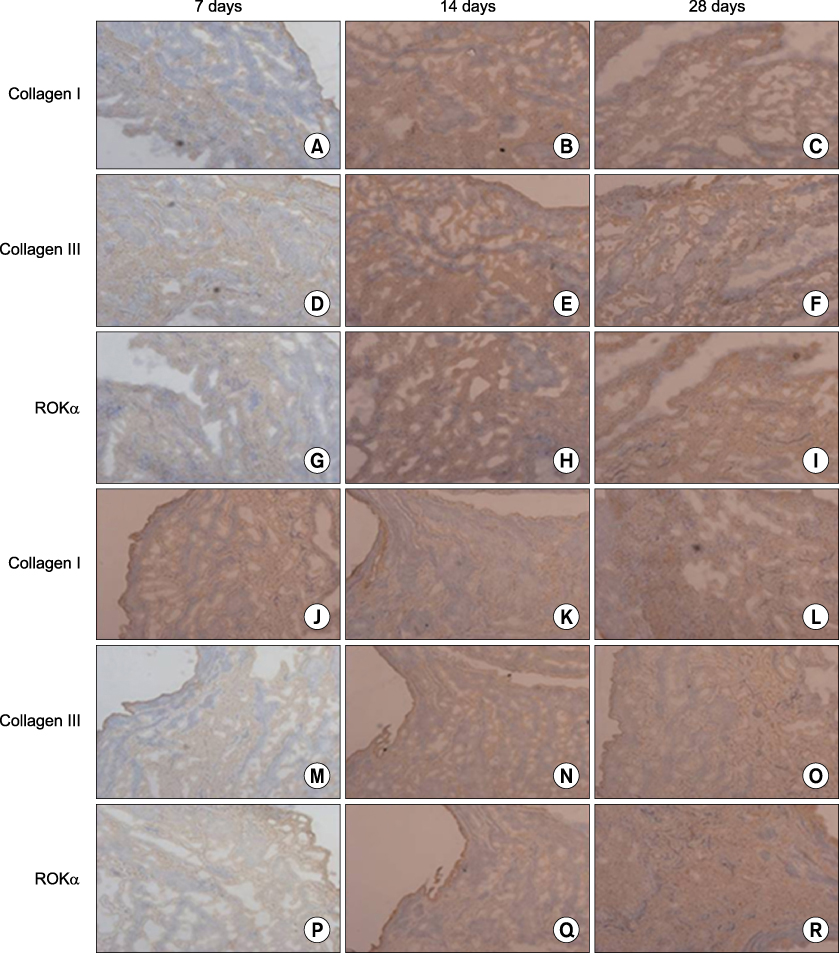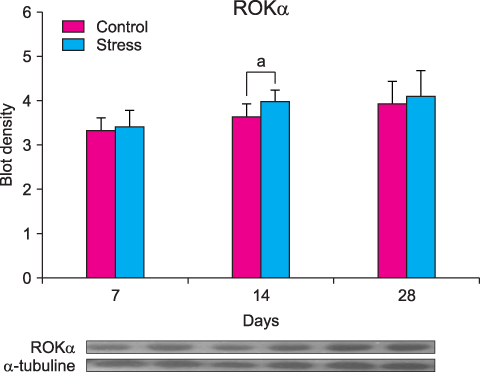Korean J Urol.
2010 Feb;51(2):132-138.
Effect of Stress on the Expression of Rho-Kinase and Collagen in Rat Bladder Tissue
- Affiliations
-
- 1Department of Urology, Medical Research Center, Ewha Womans University School of Medicine, Seoul, Korea. wowhana@ewha.ac.kr
Abstract
-
PURPOSE: We examined the effect of stress on the pathophysiology of bladder stability in terms of enzyme levels, Rho-kinase, and bladder relaxation.
MATERIALS AND METHODS
A total of 48 female Sprague-Dawley rats were studied in scheduled stress environments for 7, 14, and 28 days; 24 rats were in the control group and 24 rats were in the test (stressed) group.
RESULTS
Estrogen decreased significantly whereas testosterone and dopamine increased significantly in the stress group (p<0.05). Rho-kinase was significantly increased in the rats exposed to stress stimuli for 14 days (p<0.05). Collagen types I and III in the bladder tissue were significantly higher in rats exposed to stress for 14 days and 28 days (collagen type I in the 14-day group, p<0.01; collagen type I in the 28-day group, p<0.05; collagen type III in the 14-day and 28-day groups, p<0.05). Voiding frequency increased significantly as the duration of stress exposure was prolonged, in addition to a significant decrease in volume per voiding (p<0.05).
CONCLUSIONS
The changes observed in micturition pattern, factors that contribute to smooth muscle contraction, and relaxation in the female rat bladder support the hypothesis that stress affects bladder stability.
Keyword
MeSH Terms
Figure
Reference
-
1. Reiser MF. Reiser MF, editor. Psychophysiology of stress and its sequelae. Mind, brain, body: toward a convergence of psychoanalysis and neurobiology. 1984. New York: Basic Books;161–185.2. McVary KT, Rademaker A, Lloyd GL, Gann P. Autonomic nervous system overactivity in men with lower urinary tract symptoms secondary to benign prostatic hyperplasia. J Urol. 2005. 174:1327–1433.3. Gordon D, Groutz A. Evaluation of female lower urinary tract symptoms: overview and update. Curr Opin Obstet Gynecol. 2001. 13:521–527.4. van Os-Bossagh P, Pols T, Hop WC, Bohnen AM, Vierhout ME, Drogendijk AC. Voiding symptoms in chronic pelvic pain (CPP). Eur J Obstet Gynecol Reprod Biol. 2003. 107:185–190.5. Morrison LM, Eadie AS, McAlister A, Glen ES, Taylor J, Rowan D. Personality testing in 226 patients with urinary incontinence. Br J Urol. 1986. 58:387–389.6. Walters MD, Taylor S, Schoenfeld LS. Psychosexual study of women with detrusor instability. Obstet Gynecol. 1990. 75:22–26.7. Engström G, Henningsohn L, Steineck G, Leppert J. Self-assessed health, sadness and happiness in relation to the total burden of symptoms from the lower urinary tract. BJU Int. 2003. 95:810–815.8. Gerwin RD. A review of myofascial pain and fibromyalgia--factors that promote their persistence. Acupunct Med. 2005. 23:121–134.9. Damaser MS, Whitbeck C, Barreto M, Horan P, Benno H, O'Connor LJ, et al. Comparative physiology and biochemistry of rat and rabbit urinary bladder. BJU Int. 2000. 85:519–525.10. Wang P, Luthin GR, Ruggieri MR. Muscarinic acetylcholine receptor subtypes mediating urinary bladder contractility and coupling to GTP binding proteins. J Pharmacol Exp Ther. 1995. 273:959–966.11. Kimura K, Ito M, Amano M, Chihara K, Fukata Y, Nakafuku M, et al. Regulation of myosin phosphatase by Rho and Rho-associated kinase (Rho-kinase). Science. 1996. 273:245–248.12. Abrams P, Andersson KE. Muscarinic receptor antagonists for overactive bladder. BJU Int. 2007. 100:987–1006.13. Lluel P, Palea S, Barras M, Grandadam F, Heudes D, Bruneval P, et al. Functional and morphological modifications of the urinary bladder in aging female rats. Am J Physiol Regul Integr Comp Physiol. 2000. 278:R964–R972.14. Inaba M, Ukimura O, Yaoi T, Kawauchi A, Fushiki S, Miki T. Upregulation of heme oxygenase and collagen type III in the rat bladder after partial bladder outlet obstruction. Urol Int. 2007. 78:270–277.15. Stevenson K, Kucich U, Whitbeck C, Levin RM, Howard PS. Functional changes in bladder tissue from type III collagen-deficient mice. Mol Cell Biochem. 2006. 283:107–114.16. Deveaud CM, Macarak EJ, Kucich U, Ewalt DH, Abrams WR, Howard PS. Molecular analysis of collagens in bladder fibrosis. J Urol. 1998. 160:1518–1527.17. Yoon H, Chung WS, Park YY, Cho IH. Effects of stress on female rat sexual function. Int J Impot Res. 2005. 17:33–38.
- Full Text Links
- Actions
-
Cited
- CITED
-
- Close
- Share
- Similar articles
-
- The Effect of Stress on Bladder Stability
- Effects of Rho Kinase Inhibitor on Detrusor Overactivity after Bladder Outlet Obstruction in Rats
- The Inhibitory Mechanism of Gentamicin on Electrical Field Stimulation Response in Rat Bladder Smooth Muscle
- Change in Expression of Rho-kinase and Nitric Oxide Synthase in Penile Tissue of Rats Under Stress
- Effect of Bladder Outlet Obstruction on Blood Flow and Tissue Collagen in Rat Bladder





